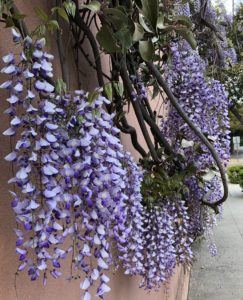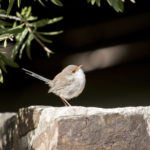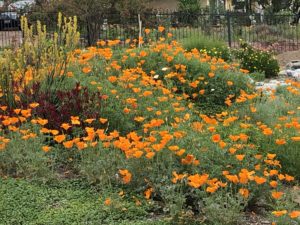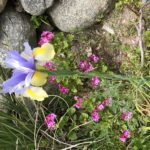 with greenery from recent rains: oak trees cascade yellow flowers thick with pollen, clusters of purple wisteria blossoms hang temptingly like bunches of grapes waiting to be plucked, rosy red camellias, magenta azaleas, bright orange clivia, all bursting with color insist on being noticed, and everywhere wafts the heady scent of citrus and jasmine in bloom. Combine this with a symphony of chirping birds, somnolent leaf blowers, the joyful sound of children playing, and one is presented with a veritable banquet for the senses! I feel extremely blessed to be able to enjoy this little corner of natural beauty and calm even as the ravages of the coronavirus wage on around the world.
with greenery from recent rains: oak trees cascade yellow flowers thick with pollen, clusters of purple wisteria blossoms hang temptingly like bunches of grapes waiting to be plucked, rosy red camellias, magenta azaleas, bright orange clivia, all bursting with color insist on being noticed, and everywhere wafts the heady scent of citrus and jasmine in bloom. Combine this with a symphony of chirping birds, somnolent leaf blowers, the joyful sound of children playing, and one is presented with a veritable banquet for the senses! I feel extremely blessed to be able to enjoy this little corner of natural beauty and calm even as the ravages of the coronavirus wage on around the world.
Orienting to Our Environment
Birds singing and children playing outdoors are sounds I remember fondly from my childhood. It makes me feel safe. Partly because I had the fortune of a happy childhood in a relatively safe neighborhood. But also, because those sounds, at the most basic level of the human autonomic nervous system, send a message to my body indicating that my environment is safe. Humans, like all mammals, have evolved to pay attention to signals in the environment to identify if danger is near. When danger is suspected, the birds also go quiet. As do children. If danger is nigh, depending on the level of threat, mammals run/fly away, fight off the predator, or go still in the hopes that the predator will not see them hiding in the bushes and pass on by. If there’s no danger, sound and activity resume. This means that the sound of the birds and children playing in their yards tells my nervous system on a fundamental level that I am in a safe environment. Mountain bird song
Mountain bird song
Coronavirus – Invisible Predator
Of course, the coronavirus is not a predator that we can see or hear coming, although we are getting plenty of warnings through the media. And despite an earlier, misguided notion that only people with symptoms of sneezing, cough and fever could spread the contagion we now know that it can exist in the air between us, and is invisibly transmittable on everyday surfaces for hours, even days after being placed there by a simple touch, or droplets from our breath. We, average neighborhood people protect ourselves by physically distancing from all but our immediate living partners. We follow orders to stay at home except for the most necessary trips to the grocery store, pharmacy, etc. We are careful to stay at least six feet apart from everybody. And cover our faces with cloth masks to safeguard others from possible contagion. We still don’t know if that actually keeps us safe. Not until there’s more testing available anyway.
contagion we now know that it can exist in the air between us, and is invisibly transmittable on everyday surfaces for hours, even days after being placed there by a simple touch, or droplets from our breath. We, average neighborhood people protect ourselves by physically distancing from all but our immediate living partners. We follow orders to stay at home except for the most necessary trips to the grocery store, pharmacy, etc. We are careful to stay at least six feet apart from everybody. And cover our faces with cloth masks to safeguard others from possible contagion. We still don’t know if that actually keeps us safe. Not until there’s more testing available anyway.
It’s very scary!
Physical Distance not Social Distance
Under the circumstances, one may be inclined to fully embrace the life of recluse. Hole up. Isolate ourselves. Stop everything non-essential. But isolation has its downside. Humans are social beings. We evolved in groups and tribes. It is part of our biological nature to form relationships with others. For survival. From birth we learn to regulate our nervous system through autonomic connection with our primary care giver. Throughout our lives we co-regulate our nervous systems through connection with others and create a shared sense of safety by identifying with a community. This is why it is so important that we find ways to stay in relationship with others even during this time of necessary physical distancing. We find such purpose and meaning in our social connections that we tend to fall into depression and poor health when we feel socially isolated or alone.
Our very chances of fighting off disease is compromised when we do not stay connected to others.
We find such purpose and meaning in our social connections that we tend to fall into depression and poor health when we feel socially isolated or alone.
Our very chances of fighting off disease is compromised when we do not stay connected to others.
Face-Heart Connection
When we are out and about, it is usual to smile and greet people to convey that we are not a threat: i.e., demonstrate that we are both members of the same community. Up until recently, we also shook hands to communicate feeling comfortable meeting someone face to face. Now, of course, that’s a No-No! We are advised against touching skin to skin with anyone except our living partners. And to stay at least six feet away! But it turns out that our bodies are built with other ways to communicate goodwill and safe presence. The muscles of our face, head, and neck are connected to the heart through the ventral vagus nerve creating an integrated social engagement system. This system regulates how we see, hear, speak and express emotions with our faces, as well as how we turn and tilt our heads, forming, in the words of Stephen Porges, author of “The Polyvagal Theory,” a “face-heart” connection. Through the social engagement system, our bodies are constantly sending and receiving signals from and to our hearts, signals of safety or danger, warning or welcoming others whether to engage. Greeting our neighbors, albeit from a physical distance, indicates that we consider ourselves a part of the same heart-felt community. Part of the same safety zone even if we must stay physically apart. We are staying apart and wearing masking to keep them safe, not just ourselves. It is our signal of investment in the community. To keep us all safe.
While we are limited in the ways we should socially engage in this time of coronavirus, it is imperative that we continue to do so.
Staying engaged with our community helps us to feel safe. As safe as we can be. This helps bolster our immune systems. Staying engaged staves off isolation and depression. Staying engaged helps us feel needed and relevant. Staying engaged helps us feel part of a cohesive community.
anyone except our living partners. And to stay at least six feet away! But it turns out that our bodies are built with other ways to communicate goodwill and safe presence. The muscles of our face, head, and neck are connected to the heart through the ventral vagus nerve creating an integrated social engagement system. This system regulates how we see, hear, speak and express emotions with our faces, as well as how we turn and tilt our heads, forming, in the words of Stephen Porges, author of “The Polyvagal Theory,” a “face-heart” connection. Through the social engagement system, our bodies are constantly sending and receiving signals from and to our hearts, signals of safety or danger, warning or welcoming others whether to engage. Greeting our neighbors, albeit from a physical distance, indicates that we consider ourselves a part of the same heart-felt community. Part of the same safety zone even if we must stay physically apart. We are staying apart and wearing masking to keep them safe, not just ourselves. It is our signal of investment in the community. To keep us all safe.
While we are limited in the ways we should socially engage in this time of coronavirus, it is imperative that we continue to do so.
Staying engaged with our community helps us to feel safe. As safe as we can be. This helps bolster our immune systems. Staying engaged staves off isolation and depression. Staying engaged helps us feel needed and relevant. Staying engaged helps us feel part of a cohesive community.
Strong Sense of Community Keeps Us Healthy
A strong sense of community is essential to our ability to fight the coronavirus. In order for large numbers of our population to shelter in place we need others more than ever. To care for the sick and the aged, to deliver groceries to those unable to go out, to collect our garbage, process our loan checks, to deliver our Amazon purchases so most of us can stay safer at home, physically distant from others. However, even more importantly, we need regular interaction with others to feel connected to our communities and to keep depression at bay. It is just as essential for our well-being that we feel needed, purposeful, and productive. The only way to ensure this is to reach out to others. So, let’s make sure that while we are physically distancing, we are not socially distancing! Task yourself daily to reach out to your world: by phone, FaceTime, Zoom, Skype. Holler a greeting to your neighbor across the driveway, smile underneath your face masks to the people you meet on your walk in the neighborhood and from a safe distance, say hello, ask how they’re doing, wave, give a thumbs up signal. Write letters, blogs, sing songs and post them on YouTube, or as my eighty-five year old mother calls it, YourTube. But stay connected. We’re all depending on each other. To stay connected, emotionally healthy, and physically safe.
So, let’s make sure that while we are physically distancing, we are not socially distancing! Task yourself daily to reach out to your world: by phone, FaceTime, Zoom, Skype. Holler a greeting to your neighbor across the driveway, smile underneath your face masks to the people you meet on your walk in the neighborhood and from a safe distance, say hello, ask how they’re doing, wave, give a thumbs up signal. Write letters, blogs, sing songs and post them on YouTube, or as my eighty-five year old mother calls it, YourTube. But stay connected. We’re all depending on each other. To stay connected, emotionally healthy, and physically safe.
 (626) 755-6437
(626) 755-6437
